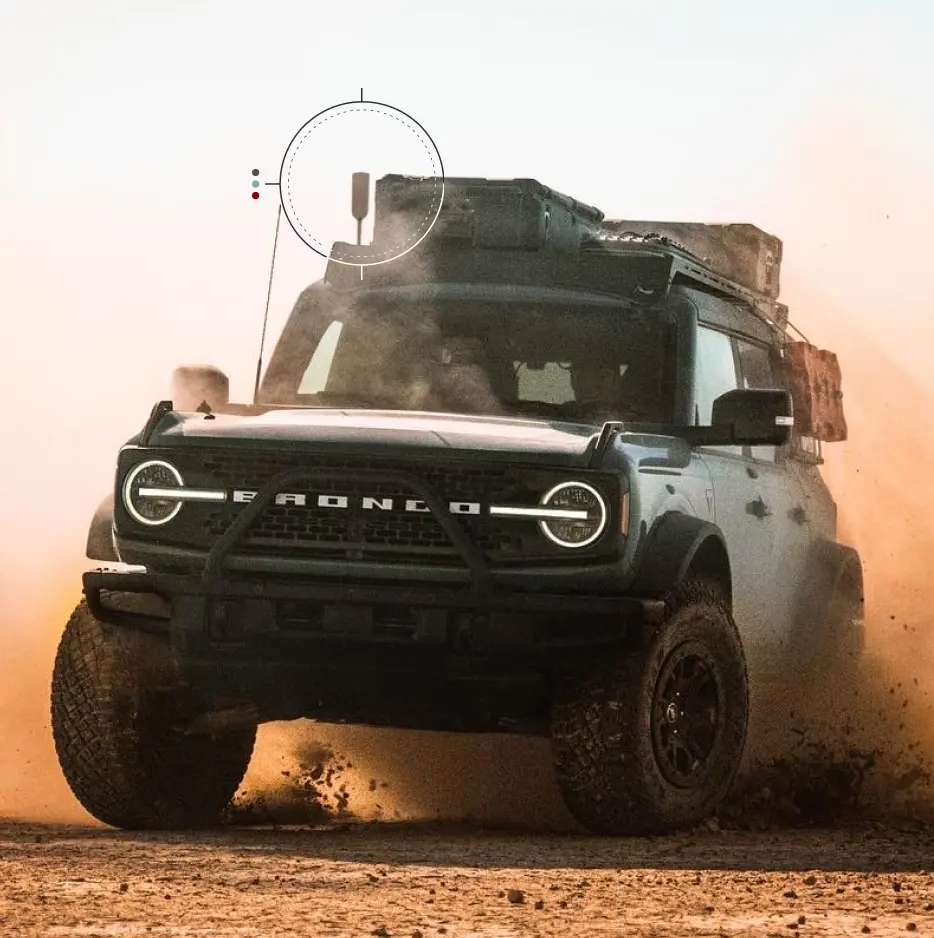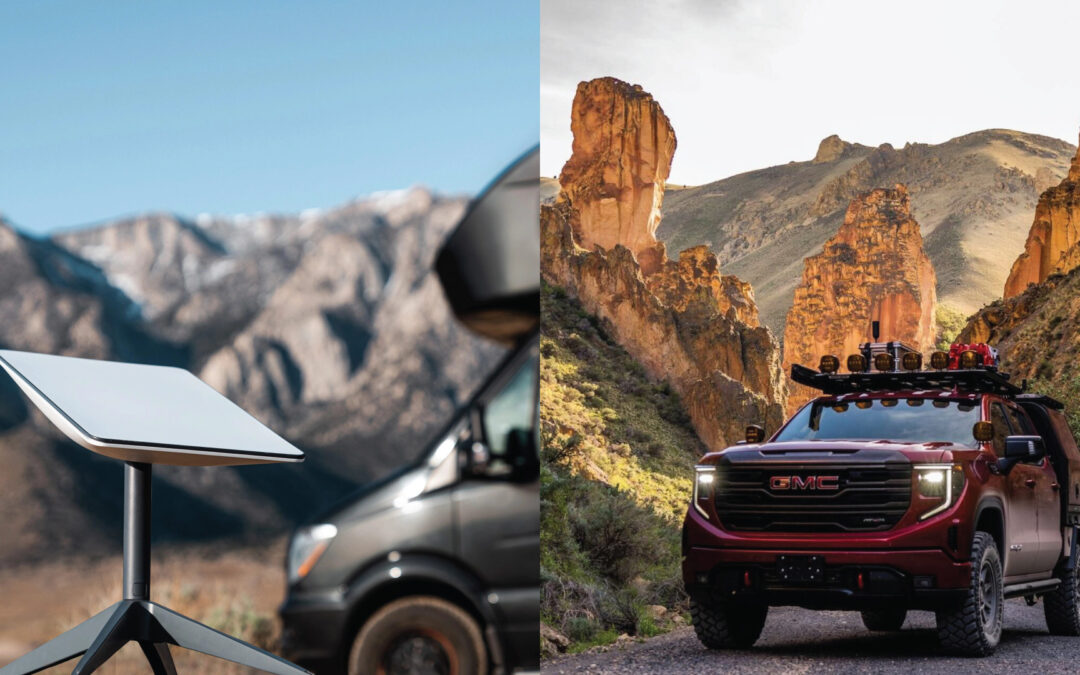Time to talk gear. This week we’re dialoguing about cell signal boosters in an age of satellite tech. Specifically Starlink vs weBoost Drive Reach Overland.
This is not a paid or endorsed article by either company mentioned and opinions are our own.
Ready? Let’s go.

First up: Starlink Roam
Starlink Roam is a mobile satellite internet solution that promises high-speed internet connectivity from virtually anywhere in the world. The system consists of a small, portable satellite dish that can be set up in just a few minutes. Once set up, it provides internet speeds of up to 150Mbps, making it one of the fastest mobile internet solutions available.
For context, a download speed of 150Mbps allows you to stream ultra-HD video on 6 devices at the same time and download an HD movie in 4 minutes.
The Cost Factor
We will not argue the benefits and advantages of having a system like Starlink Roam on your vehicle. However, the one time hardware cost for Starlink Roam Portable is $599 and the one time hardware cost for Starlink Roam In-Motion is a staggering $2,500. This is in addition to the monthly cost of $150/month for regional coverage and $200/month for global coverage.
Who Benefits
These costs make sense if you are a digital nomad, and your income is dependent upon connectivity to the internet. Or if you just like having that level of connectivity no matter what and no matter what reason.
However, for those who casually explore remote locales, cost of entry could be too steep.
Pros:
- High-speed internet connectivity from virtually anywhere in the world
- Portable and easy to set up
- No data caps or throttling
- Low latency
Cons:
- Expensive initial cost
- Monthly service subscription is required
- Requires a clear line of sight to the sky
- Limited availability or slower speeds due to high demand in some areas
weBoost Drive Reach Overland
But what about folks who don’t live full time on the road but trek to remote locations on a regular basis? This is where we see cell signal boosters step in.
The WeBoost Drive Reach Overland is a cellular signal booster that amplifies weak cellular signals to provide reliable mobile internet connectivity. The system consists of an external antenna that is mounted on the roof of the vehicle and an internal amplifier that boosts the signal strength inside the vehicle. The Drive Reach Overland promises to improve cellular signal strength by up to 74%.

The Cost Factor
The benefits of a cell signal booster hit right at the top of your wallet. There is a one time charge for the hardware, usually ~$500 so definitely not cheap, but no ongoing subscription costs and no update requirements. It’s one and done.
This could be of significant value to many types of explorers especially if the hardware is used over the course of 3-4 years.
Who Benefits
A cell signal booster is a fit for those who want data connectivity to keep apps online or the ability to communicate outward with phone calls and text messaging. This is less about accessing your favorite websites and streaming services and more about basic connection.
Now, a cell signal booster will NOT create a signal for your phone. It does what it says it does. It will use an outside antenna to snag even the faintest of signals then amplify that signal throughout your home or car.
We used a Drive Sleek by weBoost for years and I was in a constant state of surprise at the amplification that consistently occurred. The short story is that it made a difference.
Cut to 2023 when places we used to go with zero reception are now hitting 1-2 bars LTE (and even 5G) consistently. Cell signal boosters continue to be a gear investment that makes sense to us.
The Drive Reach Overland ($549.99) comes with a super buff rotating antenna and mounting accessories for your roof rack straight out of the box.

Pros:
- Improves weak cellular signal strength
- Easy to install
- No monthly service subscription required
- Compatible with multiple carriers
Cons:
- Relies on existing cellular signal, so may not work in areas with no coverage
- Limited to cellular internet speeds
- May interfere with other electronic devices
And for those who don’t want the distraction of reception when they’re in the middle of nowhere? That airplane mode is clutch.
Final Thoughts
When it comes to mobile internet solutions, both the Starlink Roam and the WeBoost Drive Reach Overland are more than viable solutions.
The Starlink Roam provides high-speed internet connectivity from virtually anywhere in the world, but at a higher initial cost and monthly service subscription.
The WeBoost Drive Reach Overland, on the other hand, provides reliable cellular signal boosting at a lower initial cost and no monthly service subscription, but is limited to cellular internet speeds.
Ultimately, the choice between the two will depend on your specific needs and travel habits (of course). Know how you want to roll and don’t get caught up in the tech gear race.
If you require high-speed internet connectivity in remote areas, the Starlink Roam is the better option.
If you primarily rely on cellular signal and want to boost your signal strength while on the road, the WeBoost Drive Reach Overland is the way to go.
And now we’re curious to hear your thoughts? What say you? Let us know in the comments.



Thanks for the write-up!
You state that WeBoost may interfere with other electronic devices.
Could you please elaborate.
Thanks again,
Richard
Richard,
The WeBoost has the small antenna (to the right of the red box in the image) that picks up your cell phone signal, sends it to the red box that then transmits a more powerful signal out the other antenna. Anytime there is a transmitter it can cause interference with things in the area. One things comes to mind is other cell phones, the data plans some cars have, etc. It is not guaranteed to cause interference, but it could.
What I find very interesting about these posts is they leave out a 3rd option, often the best option for the digital nomad: the cellular router.
A cellular router is the ultimate hotspot. They have all the key features of a hot spot, all the aspects of creating a WiFi hotspot via the cellular network with a lot more!
The biggest plus is that all cellular routers have external antennas. This is a big part of the WeBoost advantage, an external antenna that can get the signal out.
There are SO many more advantages. One is that you can connect other internet sources (Starlink, another hotspot, wired connection, any other WiFi connection!) for improved redundancy. All the good ones take two SIM cards so you can switch from one carrier to the other from the admin panel, don’t need to do anything physical!
Here is the catch, just like Starlink, you cannot make a regular phone call over a cellular router and you do need to have a data plan. At the end of the day the cellular router is really geared towards the digital nomad, not the weekend warriors.
Here is a YouTUBE video of my first digital nomad setup: https://youtu.be/z_inQSTgC-w